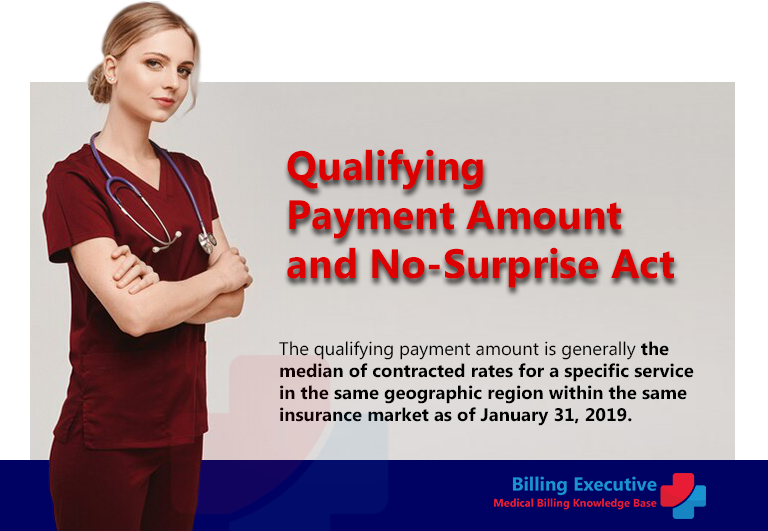The qualifying payment amount (QPA) is the foundation for determining individual cost-sharing for products and services covered by the balance-billing provisions under the No Surprises Act (NSA). The qualifying payment amount is used to calculate the patient’s cost-sharing amount for emergency and non-emergency services covered by the No Surprises Act (NSA). In addition, in the lack of an All-Payer Model Agreement or specific state legislation, the NSA allows for discussion between the health plan or health insurance issuer and the provider to decide the amount to be paid by the plan or issuer.

Use of QPA
The QPA has two applications. First, it is a consideration that will be considered during the arbitral proceedings; if a provider does not comply with the payor’s initial payment, discussions fail. The Independent Dispute Resolution method is used. Second, the Act creates a new value known as the Recognized Amount (RA). The RA serves as the foundation for calculating member cost-share. That implies that ERISA and some insured plans could no longer always figure the member cost-share based on the proper amount.
QPA calculation
The first Interim Final Rule, issued in July, explains how the QPA is calculated. It must depend on contracted rates for the same or comparable insurance market (individual, big group, small group, self-insured employer), geography and service offered in the same or similar specialty or kind of facility. The contracted rates must represent the entire provider refund amount contractually agreed upon, including cost-sharing, either under a direct or indirect agreement with the plan. The regulation states that indemnity policies with no facility network are solely eligible under the Act for emergency services since the program has no in-network facilities. Many reference-based pricing schemes currently take this form.
However, the guideline does not specify how QPA calculates emergency requests with only a professional network. When there are no in-network charges, the regulation provides two possibilities that might be considered when calculating QPA:
- An underlying fee schedule is described as the fee schedule utilized to calculate member cost-share when the contracted rate is not applied.
- A calculated amount (Paid claim history)
It is important to note that the regulation also outlines specific agreements with facilities that may be included in the RBP strategy. These agreements must be evaluated for assessing surprise bill status, but they must not be included in the calculation of QPA.
What is QPA for No-surprise Act?
A qualifing payment amount is a median contracted rate for a particular service in geographic regions within the same insurance market. According to the Act, an accurate estimate of the No Surprises Act’s median in-network fee is critical as the starting point for computing the ultimate payment for out-of-network operations. This quantity helps as the benchmark when determining patient cost-sharing limits under the Act. Patients will not be liable for any extra cost-sharing once the qualifying payment amount has been attained. The payor and provider can discuss for some time to reach an agreement on the payment amount. If such discussions fail, the provider may start arbitration under the No Surprises Act utilizing the IDR procedure if state laws are not enforced. Arbitration awards will be reported publicly as a proportion of this amount.
Consider QPA as part of your initial payment strategy.
QPA has a significant impact on the arbitration process that should be factored into the payor’s initial payment plan. It should be noted that the No Surprises Act does not compel the plan to compensate the provider through the QPA. The Act does not specify how the payor decides the acceptable amount; thus, any existing out-of-network cost management and reference-based pricing systems may continue. A payor’s reimbursement might be at, above, or below the QPA if those or other services are used. Unless the original payment is made through a network contract or pre-payment negotiation, the conclusion will affect the post-payment negotiating process and arbitration.
To learn more about QPA or no surprise act, visit our website. We have articles on CPT, No surprise act and QPA for your information. If you have any concerns email us at rcmexpertz@gmail.com
About us
Billing Executive – a Medical Billing and Coding Knowledge Base for Physicians, Office staff, Medical Billers and Coders, including resources pertaining to HCPCS Codes, CPT Codes, ICD-10 billing codes, Modifiers, POS Codes, Revenue Codes, Billing Errors, Denials and Rejections.
We have more than 10 years experience in US Medical Billing and hand-on experience in Web Management, SEO, Content Marketing & Business Development with Research as a special forte.
Learn More
Payment Posting Representative (Physicians’ Billing)
Common Coding Denials You Should Be Aware for Faster Payments
No Surprises Act (NSA) and TDI IDR/Mediation
No Surprises Act (NSA), Federal IDR, and how does it work?
